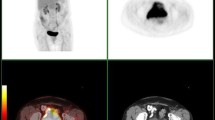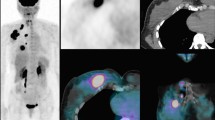Abstract
F-fluorodeoxyglucose (FDG) positron emission tomography–computed tomography (PET/CT) has of late gained prominence in the investigation of cervical cancer since it gives a better clarity on imaging modalities for the status of the lymph node and distant metastasis. The current review is an appraisal of the recent updates on the role of FDG-PET/CT in the screening of cervical cancer as evidenced by publications till date. 985 studies were obtained in the initial search on cervical cancer and publications selected based on inclusion and exclusion criteria. In the final selection, 14 were selected and coded as the most appropriate for the present review. Valuable studies on (FDG) PET/CT have been identified. These studies point to the fact that recent advanced protocols like PET/CT supported by therapeutic innovations ensure better cancer care and survival chances in cervical cancer patients.
Similar content being viewed by others
References
Clarke, M., & Oxman, A. (2003). Cochrane Reviewers’ Handbook 4.2.0. http://www.cochrane.dk/cochrane/handbook/handbook.html.
Higgins, J. P. T., & Green, S. (Eds.). (2005). Cochrane Handbook for Systematic Reviews of Interventions 4.2.5. In The Cochrane Library. Chichester: John Wiley & Sons, Ltd.
Mayhew, A. (2002). EPOC: The data collection checklist. Ontario: The Cochrane Effective Practice and Organisations of Care Review Group.
Garces, A. H., Mora, P. A., Alves, F. V., do Carmo, C. C., Grazziotin, R., Fernandes, A. C., et al. (2013). First-line paclitaxel and carboplatin in persistent/recurrent or advanced cervical cancer: A retrospective analysis of patients treated at Brazilian National Cancer Institute. International Journal of Gynecological Cancer, 23, 743–748.
Herrera, F. G., & Prior, J. O. (2013). The role of PET/CT in cervical cancer. Frontier in Oncology, 3, 34.
Gu, J., Li, X., Liang, Y., Qiao, L., Ran, D., Lu, Y., et al. (2013). Upregulation of URI/RMP gene expression in cervical cancer by high-throughput tissue microarray analysis. International Journal of Clinical and Experimental Pathology, 6(4), 669–677.
Netzer, I., Sobeh, S., Keidar, Z., Lowenstein, L., Lavie, O., Yosef, R. B., et al. (2013). To operate or to radiate: The added value of the maximal standardized uptake value in PET-FDG in cervical cancer patients. Medical Oncology, 30(2), 558.
Ai, Z., Wang, J., Xu, Y., & Teng, Y. (2013). Bioinformatics analysis reveals potential candidate drugs for cervical cancer. The Journal of Obstetrics and Gynaecology Research. doi:10.1111/jog.12022.
Barney, B. M., Petersen, I. A., Dowdy, S. C., Bakkum-Gamez, J. N., Klein, K. A., & Haddock, M. G. (2013). Intraoperative Electron Beam Radiotherapy (IOERT) in the management of locally advanced or recurrent cervical cancer. Radiation Oncology, 8(1), 80.
Cai, L., Yang, S., Ding, H., Cai, J., & Wang, Z. (2013). Tumor-associated lymphatic endothelial cell promotes invasion of cervical cancer cells. APMIS. doi:10.1111/apm.12068.
Mazeron, R., Gilmore, J., Dumas, I., Champoudry, J., Goulart, J., Vanneste, B., et al. (2013). Adaptive 3D image-guided brachytherapy: A strong argument in the debate on systematic radical hysterectomy for locally advanced cervical cancer. Oncologist, 18, 415–422.
Puranik, A. D., Purandare, N. C., Dua, S., Deodhar, K., Shah, S., Agrawal, A., et al. (2013). Isolated mandibular condylar metastases: An uncommon manifestation of recurrent cervical cancer. Journal of Cancer Research and Therapeutics, 9(1), 108–110.
Chong, A., Ha, J. M., Jeong, S. Y., Song, H. C., Min, J. J., Bom, H. S., et al. (2013). Clinical usefulness of 18F-FDG PET/CT in the detection of early recurrence in treated cervical cancer patients with unexplained elevation of serum tumor markers. Chonnam Medical Journal, 49(1), 20–26.
Onal, C., Oymak, E., Findikcioglu, A., & Reyhan, M. (2013). Isolated mediastinal lymph node false positivity of [18F]-fluorodeoxyglucose-positron emission tomography/computed tomography in patients with cervical cancer. International Journal of Gynecological Cancer, 23(2), 337–342.
Olsen, J. R., Esthappan, J., DeWees, T., Narra, V. R., Dehdashti, F., Siegel, B. A., et al. (2013). Tumor volume and subvolume concordance between FDG-PET/CT and diffusion-weighted MRI for squamous cell carcinoma of the cervix. Journal of Magnetic Resonance Imaging, 37(2), 431–434.
Akkas, B. E., Demirel, B. B., & Vural, G. U. (2012). Clinical impact of 18F-FDG PET/CT in the pretreatment evaluation of patients with locally advanced cervical carcinoma. Nuclear Medicine Communications, 33(10), 1081–1088.
Wagholikar, K. B., Maclaughlin, K. L., Kastner, T. M., Casey, P. M., Henry, M., Greenes, R. A., et al. (2013). Formative evaluation of the accuracy of a clinical decision support system for cervical cancer screening. Journal of American Medical Informatics Association, 20, 749–757.
Zhao, K., Luo, X. M., Zhou, S. H., Liu, J. H., Yan, S. X., Lu, Z. J., et al. (2012). 18F-fluorodeoxyglucose positron emission tomography/computed tomography as an effective diagnostic workup in cervical metastasis of carcinoma from an unknown primary tumor. Cancer Biotherapy and Radiopharmaceuticals, 27(10), 685–693.
Møller, A. K., Loft, A., Berthelsen, A. K., Pedersen, K. D., Graff, J., Christensen, C. B., et al. (2012). A prospective comparison of 18F-FDG PET/CT and CT as diagnostic tools to identify the primary tumor site in patients with extracervical carcinoma of unknown primary site. Oncologist, 17(9), 1146–1154.
Roh, J. L., Kim, J. S., Lee, J. H., Cho, K. J., Choi, S. H., Nam, S. Y., et al. (2009). Utility of combined 18F-fluorodeoxyglucose-positron emission tomography and computed tomography in patients with cervical metastases from unknown primary tumors. Oral Oncology, 45, 218–224.
Chung, H. H., Kim, J. W., Han, K. H., Eo, J. S., Kang, K. W., Park, N. H., et al. (2011). Prognostic value of metabolic tumor volume measured by FDG-PET/CT in patients with cervical cancer. Gynecologic Oncology, 120(2), 270–274.
Leseur, J., Devillers, A., Williaume, D., Le Price, E., Fougerou, C., Bouriel, C., et al. (2011). (18F)-Fluorodeoxyglucose PET/CT in cervix cancer: Lymph node assessment and prognostic/predictive value of primary tumour analysis. Cancer Radiotherapy, 15(8), 699–708.
Chung, H. H., Kim, J. W., Kang, K. W., Park, N. H., Song, Y. S., Chung, J. K., et al. (2012). Predictive role of post-treatment [18F]FDG PET/CT in patients with uterine cervical cancer. European Journal of Radiology, 81(8), e817–e822.
Olsen, J. R., Dehdashti, F., Siegel, B. A., Zighelboim, I., Grigsby, P. W., & Schwarz, J. K. (2011). Prognostic utility of squamous cell carcinoma antigen in carcinoma of the cervix: Association with pre- and posttreatment FDG-PET. International Journal of Radiation Oncology Biology Physics, 81(3), 772–777.
Bentivegna, E., Uzan, C., Gouy, S., Leboulleux, S., Duvillard, P., Lumbroso, J., et al. (2010). Correlation between [18F] fluorodeoxyglucose positron-emission tomography scan and histology of pelvic nodes in early-stage cervical cancer. Anticancer Research, 30(3), 1029–1032.
Drolet, M., Boily, M. C., Greenaway, C., Deeks, S. L., Blanchette, C., Laprise, J. F., et al. (2013). Sociodemographic inequalities in sexual activity and cervical cancer screening: Implications for the success of human papillomavirus vaccination. Cancer Epidemiology, Biomarkers and Prevention, 22(4), 641–652.
Conflict of Interest
The authors declare that the research work was carried out in the absence of any grant, funding, or any financial assistance that could be construed as a potential conflict of interest.
Author information
Authors and Affiliations
Corresponding author
Rights and permissions
About this article
Cite this article
Guo, F., Yang, R., Tian, J. et al. The Role of F-Fluorodeoxyglucose (FDG) Positron Emission Tomography–Computed Tomography (PET/CT) in the Screening of Cervical Cancer: A Literature Review. Cell Biochem Biophys 69, 197–201 (2014). https://doi.org/10.1007/s12013-013-9788-0
Published:
Issue Date:
DOI: https://doi.org/10.1007/s12013-013-9788-0




